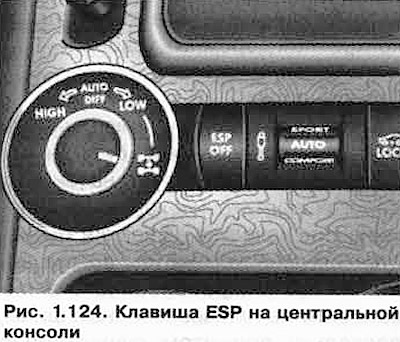Purpose of differential lock
The locking center and rear differentials are used to increase the vehicle's patency in off-road conditions and facilitate movement on steep slopes.
When driving in curves, the outer wheel travels a greater distance than the inner wheel. Therefore, the wheels of one axle move at different speeds, and in order for the car to move normally, an axle differential is needed. The center differential equalizes the speed of rotation of the drive shafts of the front and rear axles, and the rear axle differential equalizes the rear wheels.
Center differential lock
Prevents one axle from spinning in place on slippery ground while the wheels of the other axle are stationary on a non-slip pound.
When the center differential lock is engaged, torque begins to flow to both axles, since the front and rear axles become rigidly connected. The torque from the power plant is automatically redistributed along the axles in accordance with the condition of the ground under the wheels.
Rear axle differential lock
Rigidly ties the rear wheels so they turn at the same speed. The rear axle differential lock is only possible with the center differential locked.
NOTE: Disabling the center differential lock when turning the wheels can be replaced by a very sensitive jerk. The reason for this is a sharp decrease in the amount of stress in the transmission that occurred at the beginning of the turn with the differential lock on.
NOTE: With wheel differentials engaged «scrape» on the ground when turning. This is noticeable in the resulting noise.
NOTE: Steering angle is severely limited when differential locks are engaged.
Engage differential lock
Reduce speed below 40 km/h.
Rotate button out of position «HIGH» (pic. 1.124) through position «LOW» to the lock position of the corresponding differential.

The first pictogram along the button indicates the position of the center differential lock, and the next and last icon indicates the position of the rear axle differential lock.
Turning the button only selects the lock of a certain differential. The process of engaging and disengaging the differential lock itself may take some time.
If it happens that you cannot turn the lock on or off, take your foot off the gas pedal and drive as straight as possible, while making slight movements of the steering wheel left and right.
When Not to Engage Differential Lock
NOTE: Under no circumstances should the differential locks be engaged while driving on normal public roads, or when the wheels are spinning, the vehicle is being towed, or the brakes are being tested on a roller stand.
NOTE: Under no circumstances should the differential locks be engaged when driving on normal roads or when one of the wheels is slipping. If you turn on the lock at the moment when the wheel is slipping, either a drive failure or a sudden and uncontrolled movement of the car is possible. In addition, the steering action will be immediately limited.
WARNING: When the differential locks are engaged while driving on normal public roads, or when the wheels are spinning, the vehicle is being towed, or the brakes are being checked on a roller stand, either the drive may fail or the vehicle may move suddenly and uncontrollably.

Visitor comments